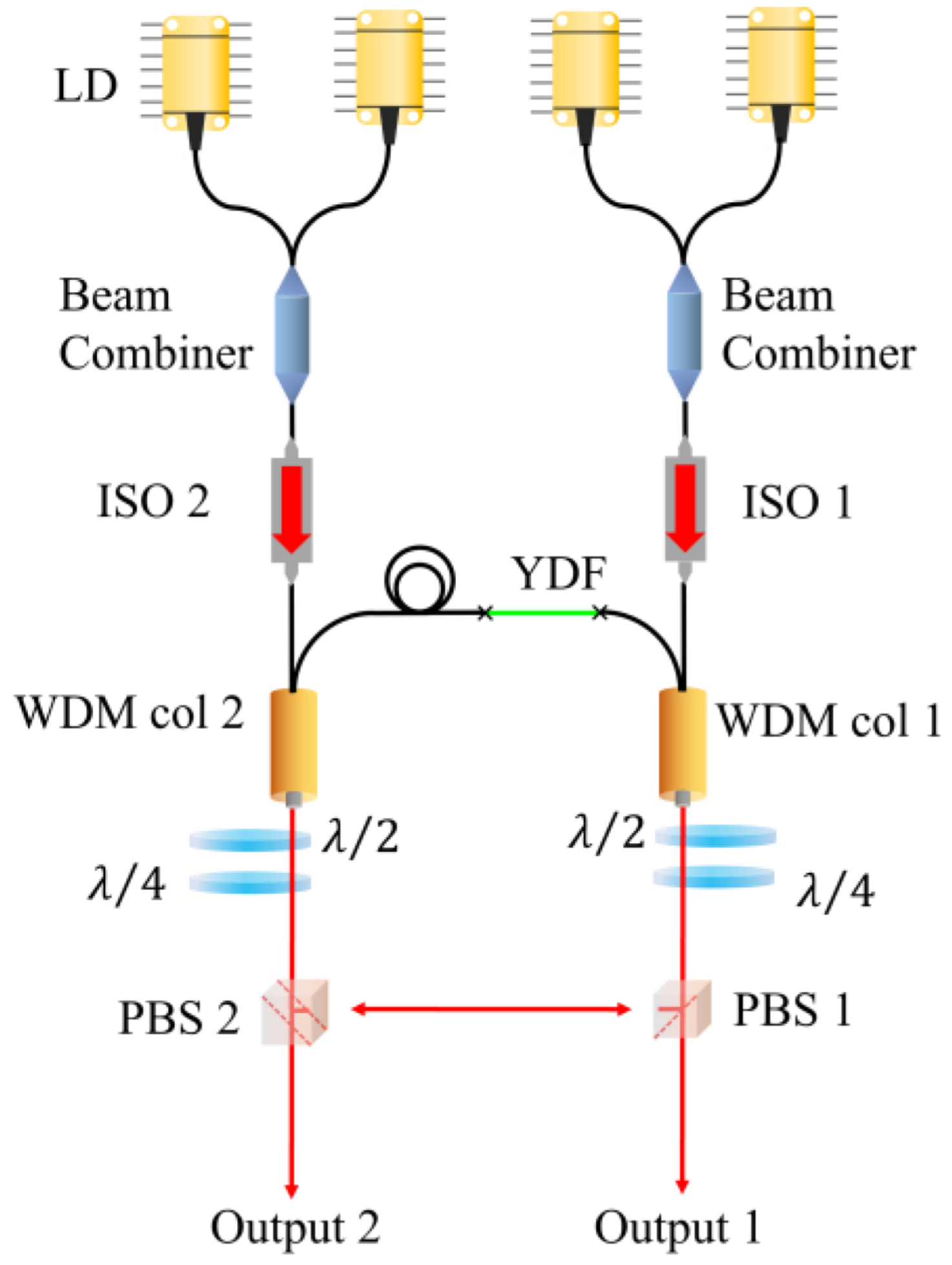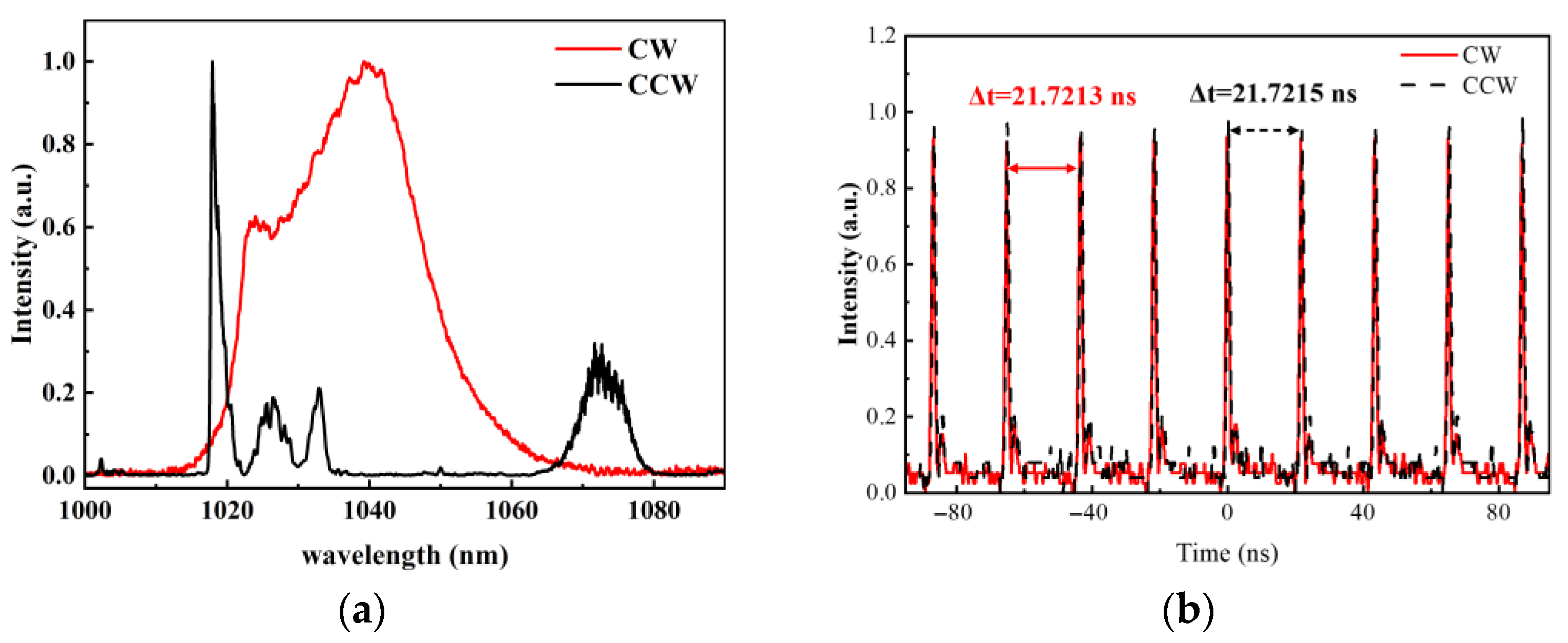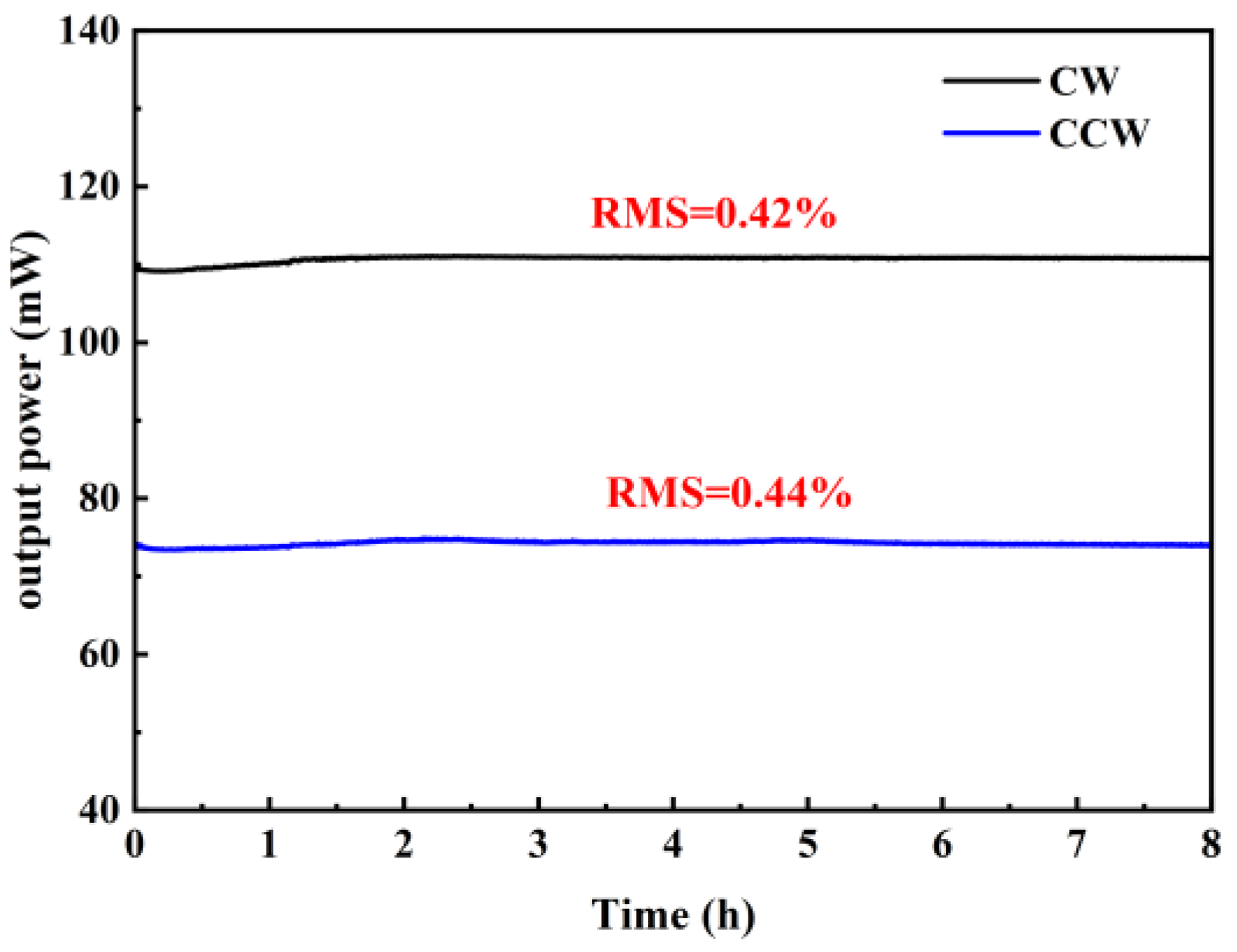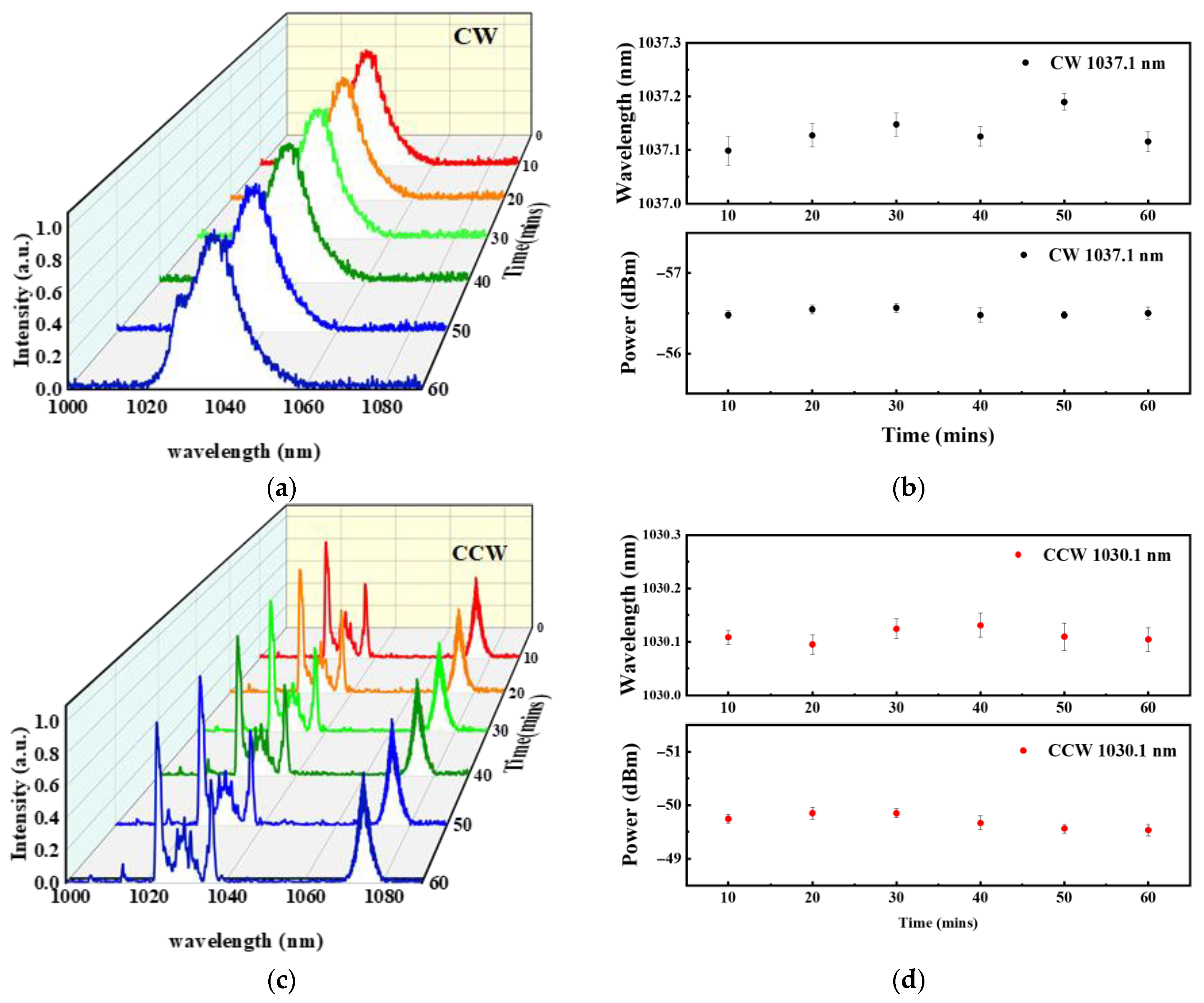Generation of 27 nm Spectral Bandwidth, Two-Port Output Pulses Directly from a Yb-Doped Fiber Laser
Abstract
1. Introduction
2. Experimental Setup and Principles
3. Results and Discussion
4. Conclusions
Author Contributions
Funding
Institutional Review Board Statement
Informed Consent Statement
Data Availability Statement
Conflicts of Interest
References
- Huang, L.; Yang, C.; Tan, T.; Lin, W.; Zhang, Z.; Zhou, K.; Zhao, Q.; Teng, X.; Xu, S.; Yang, Z. Sub-kHz-linewidth wavelength-tunable single-frequency ring-cavity fiber laser for C-and L-band operation. J. Light. Technol. 2021, 39, 4794–4799. [Google Scholar] [CrossRef]
- Liu, D.; Huang, B.; Yang, L.; Wu, J.; Li, N.; Miao, L.; Zhao, C. Widely tunable narrow linewidth dual-wavelength Yb-doped fiber laser with inhomogeneous polarization output. J. Light. Technol. 2023, 41, 327–332. [Google Scholar] [CrossRef]
- Wu, H.; Jiang, C.; Tian, S.; Shao, S.; Yue, H.; Cui, X.; Gao, B.; Wang, X.; Chen, P. Multifunctional single-fiber optical tweezers for particle trapping and transport. Chin. Opt. Lett. 2022, 20, 121201. [Google Scholar] [CrossRef]
- Zhao, Q.; Chu, H.; Pan, Z.; Liu, B.; Pan, H.; Zhao, S.; Li, D. Preparation of amorphous silicon-doped Y2O3 aerogel enabling nonlinear optical features for ultrafast photonics. Nanophotonics 2024, 13, 1611–1621. [Google Scholar] [CrossRef]
- Pan, Y.; Lu, Q.; Ma, T.; Zhang, D.; Pan, H.; Liang, L. All-polarization-maintaining Figure-9 erbium-doped mode-locked fiber laser based on a bidirectionally pumped weak asymmetric NALM. Appl. Opt. 2024, 63, 8034–8043. [Google Scholar] [CrossRef]
- Norihiko, N.; Hayato, S.; Masahito, Y. Investigation of dispersion-managed, polarization-maintaining Er-doped figure-nine ultrashort-pulse fiber laser. Opt. Express 2019, 27, 19218–19232. [Google Scholar]
- Lau, K.Y.; Luo, Z.C.; Lin, J.W.; Xu, B.B.; Liu, X.F.; Qiu, J.R. Development of Figure-of-Nine Laser Cavity for Mode-Locked Fiber Lasers: A Review. Laser Photonics Rev. 2025, 19, 2301239. [Google Scholar] [CrossRef]
- Viskontas, K.; Regelskis, K.; Rusteika, N. Slow and fast optical degradation of the SESAM for fiber laser mode-locking at 1 μm. Lith. J. Phys. 2014, 54, 127–135. [Google Scholar] [CrossRef]
- Fu, W.; Wright, G.L.; Sidorenko, P.; Backus, S.; Wise, W.F. Several new directions for ultrafast fiber lasers [Invited]. Opt. Express 2018, 26, 9432–9463. [Google Scholar] [CrossRef]
- Yang, S.; Smith, C.R.; Petersen, R.C.; Bang, O. All-Fiber 2 µm Mamyshev Oscillator: Mapping of Different Operating Regimes. Laser Photonics Rev. 2025, 19, 2500074. [Google Scholar] [CrossRef]
- Hu, P.; Mao, J.J.; Zhou, X.; Feng, T.L.; Nie, H.K.; Zhang, B.T.; Li, T.; He, J.; Yang, K. 603 MHz Harmonic Mode-Locked Femtosecond Ho-Doped Fiber Laser. J. Light. Technol. 2024, 42, 3862–3868. [Google Scholar] [CrossRef]
- Ye, G.; Chow, K.K.; Liu, B.; Dai, M.; Ma, Y.; Shirahata, T.; Yamashita, S.; Set, S.Y. L-band mode-locked fiber laser using all polarization-maintaining nonlinear polarization rotation. Opt. Lett. 2023, 48, 4729–4732. [Google Scholar] [CrossRef] [PubMed]
- Alamgir, I.; Rochette, M. Thulium-doped fiber laser mode-locked by nonlinear polarization rotation in a chalcogenide tapered fiber. Opt. Express 2022, 30, 14300–14310. [Google Scholar] [CrossRef]
- Yan, L.; Lin, Q.; Song, Y.; Jia, X.; Tao, J.; Li, Y.; Song, p.; Jiang, M. Noise-like Mode-locked Er: Fiber Laser Based on Nonlinearity Management. Acta Photonica Sin. 2022, 51, 0514001. [Google Scholar]
- Chen, H.; Li, Y.; Huang, D.; Li, F.; Lu, C.; Wai, P.K.A. 114 nm broadband all-fiber nonlinear polarization rotation mode locked-laser and time-stretch optical coherence tomography. Opt. Express 2021, 29, 33322–33330. [Google Scholar] [CrossRef]
- Wang, Y.; Tian, H.; Ma, Y.; Song, Y.; Zhang, Z. Timing jitter of high-repetition-rate mode-locked fiber lasers. Opt. Lett. 2018, 43, 4382–4385. [Google Scholar] [CrossRef]
- Li, W.L.; Wu, Y.L.; Xu, S.H.; Wang, P.; Chen, Y.; Dawid, P. Dual Wavelength Pumping Scheme for Directly Diode-Pumped 75X-nm Fiber Lasers. J. Light. Technol. 2023, 41, 7006–7013. [Google Scholar] [CrossRef]
- Lin, Q.; Yan, L.; Song, Y.; Jia, X.; Feng, X.; Hou, L.; Bai, J. Switchable single- and dual-wavelength femtosecond mode-locked Er-doped fiber laser based on carboxyl-functionalized graphene oxide saturable absorber. Chin. Opt. Lett. 2021, 19, 111405. [Google Scholar] [CrossRef]
- Zhang, Z.X.; Xu, K.; Wu, J.; Hong, X.B.; Lin, J.T. Two Different Operation Regimes of Fiber Laser Based on Nonlinear Polarization Rotation: Passive Mode-Locking and Multiwavelength Emission. IEEE Photonics Techno. Lett. 2008, 20, 979–981. [Google Scholar] [CrossRef]
- Zhang, Z.X.; Ye, Z.Q.; Sang, M.H.; Nie, Y.Y. Nonlinear-polarization-rotation based multiwavelength erbium-doped fiber lasers with highly nonlinear fiber. Laser Phys. 2011, 21, 1820. [Google Scholar] [CrossRef]
- Guo, B.; Guo, X.Y.; Tang, L.G.; Yang, W.L.; Chen, Q.M.; Ren, Z.Y. Ultra-long-period grating-based multi-wavelength ultrafast fiber laser. Chin. Opt. Lett. 2021, 19, 071405. [Google Scholar] [CrossRef]
- Zhang, L.; Xu, Y.P.; Lu, P.; Mihailov, S.; Chen, L.; Bao, X.Y. Multi-Wavelength Brillouin Random Fiber Laser via Distributed Feedback From a Random Fiber Grating. J. Light. Technol. 2018, 36, 2122–2128. [Google Scholar] [CrossRef]
- Ebrahimzadeh, S.; Adnan, S.; Li, Y.; Pecile, V.; Fellinger, J.; Salman, S.; Heyl, C.; Heckl, O.; Porat, G. Spectrally tunable phase-biased NALM mode-locked Yb:fiber laser with nJ-level pulse energy. J. Phys. Photonics 2024, 6, 02LT01. [Google Scholar] [CrossRef]
- Shi, Y.; Peng, Z.; Cheng, Z.; Xia, T.; Zhao, H.; Wan, S. All-Fiber Polarization-Maintaining Dispersion-Managed Figure-of-9 Mode-Locked Laser. IEEE Photonics Technol. Lett. 2022, 34, 251–254. [Google Scholar] [CrossRef]
- Duan, L.; Yang, X.; Feng, X.; Bai, Y.; Guo, J.; Yu, J. Dual-Axis Independent Mode-Locked, All-Polarization-Maintaining Femtosecond Laser. IEEE Photonics Technol. Lett. 2025, 37, 929–932. [Google Scholar] [CrossRef]
- Peng, S.; Liu, X.; Fu, H.; Li, Q. Intracavity filtering effect in a dual-output linear-cavity all-PM fiber laser mode-locked by NPE. Appl. Opt. Lett. 2023, 62, 6323–6332. [Google Scholar] [CrossRef]
- Chang, K.Y.; Wang, R.C.; Yu, H.C.; Liu, J.M. Ultra-broadband supercontinuum covering a spectrum from visible to mid-infrared generated by high-power and ultrashort noise-like pulses. Opt. Express 2021, 29, 26775–26786. [Google Scholar] [CrossRef]
- Keren, S.; Brand, E.; Levi, Y.; Horowitz, M. Data storage in optical fibers and reconstruction by use of low-coherence spectral interferometry. Opt. Lett. 2002, 27, 125–127. [Google Scholar] [CrossRef] [PubMed]
- Lecaplain, C.; Ortaç, B.; Hideur, A. High-energy femtosecond pulses from a dissipative soliton fiber laser. Opt. Lett. 2009, 34, 3731–3733. [Google Scholar] [CrossRef] [PubMed]
- Pan, L.; Utkin, I.; Fedosejevs, R. Two-wavelength ytterbium-doped fiber laser with sustained relaxation oscillation. Appl. Opt. 2009, 48, 5484–5489. [Google Scholar] [CrossRef] [PubMed]
- Yang, R.; Zhao, M.; Jin, X.; Li, Q.; Chen, Z.; Wang, A.; Zhang, Z. Attosecond timing jitter from high repetition rate femtosecond “solid-state fiber lasers”. Optica 2022, 9, 874–877. [Google Scholar] [CrossRef]
- Jeong, Y.; Vazquez-Zuniga, L.A.; Lee, S.; Kwon, Y. On the formation of noise-like pulses in fiber ring cavity configurations. Opt. Fiber Technol. 2014, 20, 575–592. [Google Scholar] [CrossRef]
- Lang, J.; Lv, C.; Lu, B.; Bai, J. Mechanism of noise-like pulse in all-normal dispersion all-fiber laser based on nonlinear polarization rotation. Opt. Express 2024, 32, 2392–2404. [Google Scholar] [CrossRef] [PubMed]
- Zhou, Y.; Chu, X.; Qian, Y.; Liang, C.; Komarov, A.; Tang, X.; Tang, M.; Zhu, H.; Zhao, L. Investigation of noise-like pulse evolution in normal dispersion fiber lasers mode-locked by nonlinear polarization rotation. Opt. Express 2022, 30, 35041–35049. [Google Scholar] [CrossRef]
- Tang, D.Y.; Zhao, L.M.; Zhao, B. Soliton collapse and bunched noise-like pulse generation in a passively mode-locked fiber ring laser. Opt. Express 2005, 13, 2289–2294. [Google Scholar] [CrossRef]
- Zhao, L.M.; Tang, D.Y.; Wu, J.; Fu, X.Q.; Wen, S.C. Noise-like pulse in a gain-guided soliton fiber laser. Opt. Express 2007, 15, 2145–2150. [Google Scholar] [CrossRef]







Disclaimer/Publisher’s Note: The statements, opinions and data contained in all publications are solely those of the individual author(s) and contributor(s) and not of MDPI and/or the editor(s). MDPI and/or the editor(s) disclaim responsibility for any injury to people or property resulting from any ideas, methods, instructions or products referred to in the content. |
© 2025 by the authors. Licensee MDPI, Basel, Switzerland. This article is an open access article distributed under the terms and conditions of the Creative Commons Attribution (CC BY) license (https://creativecommons.org/licenses/by/4.0/).
Share and Cite
Chen, J.; Hu, M.; Chen, J.; Zou, C.; Zhao, Z.; Zhong, G.; Yuan, S. Generation of 27 nm Spectral Bandwidth, Two-Port Output Pulses Directly from a Yb-Doped Fiber Laser. Photonics 2025, 12, 812. https://doi.org/10.3390/photonics12080812
Chen J, Hu M, Chen J, Zou C, Zhao Z, Zhong G, Yuan S. Generation of 27 nm Spectral Bandwidth, Two-Port Output Pulses Directly from a Yb-Doped Fiber Laser. Photonics. 2025; 12(8):812. https://doi.org/10.3390/photonics12080812
Chicago/Turabian StyleChen, Junyu, Mengyun Hu, Jianing Chen, Chixuan Zou, Zichen Zhao, Gantong Zhong, and Shuai Yuan. 2025. "Generation of 27 nm Spectral Bandwidth, Two-Port Output Pulses Directly from a Yb-Doped Fiber Laser" Photonics 12, no. 8: 812. https://doi.org/10.3390/photonics12080812
APA StyleChen, J., Hu, M., Chen, J., Zou, C., Zhao, Z., Zhong, G., & Yuan, S. (2025). Generation of 27 nm Spectral Bandwidth, Two-Port Output Pulses Directly from a Yb-Doped Fiber Laser. Photonics, 12(8), 812. https://doi.org/10.3390/photonics12080812






